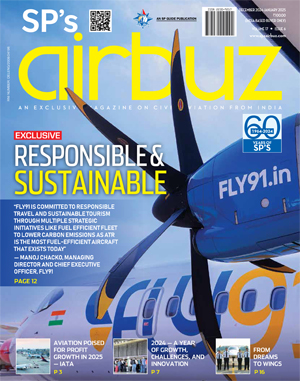Sensible and Safe

Aviation regulators, pilots and airlines now have a proactive approach to safety, meticulously compiling and sharing information about flying hazards with the goal of anticipating and preventing accidents rather than merely adopting a reactive approach
Is commercial aviation becoming safer? The gratifying answer is yes. According to Aviation Safety Network, a reputed accident research agency, last year was the safest since 1945. Globally, year 2012 saw just 23 fatal accidents and 475 deaths against 42 fatal crashes and 1,147 deaths in 2000. Some of the reasons for this dramatically improved performance are evident. Commercial aircraft are becoming more reliable with each passing year and their engines are far less likely to quit. Advancements in the cockpit and trustworthy avionics mean that the load on the flight crew is minimised while sophisticated warning and navigation devices ensure that the once-common causes of accidents such as mid-air collisions, landing accidents in bad weather and controlled flight into terrain (CFIT), have been drastically reduced. There are also less obvious reasons why accident rates are plummeting, especially in the advanced countries. Aviation regulators, pilots and airlines now have a proactive approach to safety, meticulously compiling and sharing information about flying hazards with the goal of anticipating and preventing accidents rather than merely adopting a reactive approach. Indeed, the flying environment has never been safer and that is something to celebrate.
Continental Chasm
But in the flight safety arena, something always remains to be done. For instance, while North America is the safest continent with a very low accident rate, Africa accounts for 22 per cent of all fatal airliner accidents even though it hosts just three per cent of global departures. Even in the US, the safety record in respect of regional aviation is hardly inspiring. Regional airlines have been involved in five of the seven fatal accidents that struck scheduled airline flights in the past decade. In four of these accidents, pilot error was cited as a cause. So what does that say about training and “safety first” culture? The most recent of these deadly mishaps, the one involving Flight 3407 of Colgan Air, was attributable to inadequate training and insufficient regulation. Flight 3407 was operated by regional carrier Colgan Air for Continental Airlines under the brand name Continental Express. In February 2009, it crashed near Buffalo, New York, killing all 49 aboard. The cause was an incorrect response by the Captain to two key stall warning devices on the 74-seat Bombardier Q400 turboprop, one of the safest regional aircraft flying today. After the crash, it emerged that regional carriers in the US routinely hired younger pilots with as little as 250 hours of flight experience, worked them to the bone, yet paid them far lower wages than the major airlines—all quite legal under the US Federal Aviation Administration (FAA) rules.
In many countries, including India, there is no reduction in the crew experience requirement for regional airlines. This is eminently sensible. However, it happens everywhere that the major carriers grab the best and brightest talent, leaving the smaller regional enterprises to fight over the left overs. In this country too, a regional airline is seen as a mere stepping stone to a more lucrative job with a prestigious airline. And India’s regional airlines are still in the doldrums. Since the Ministry of Civil Aviation introduced its policy on scheduled regional air transport operations in August 2007, just one regional carrier, MDLR Airlines, operated on a small scale and soon folded up. Now there is only Air Mantra with two small planes on very limited routes in the northern region. But it has recently temporarily suspended operations. However, on the brighter side, major airlines such as Spice- Jet and Jet Airways are keeping the regional aviation flag flying by connecting several Tier-II and Tier-III cities to the nearest metro or major city with the help of Bombardier Q400 NextGen, ATR 72-500 and ATR 72-600 turboprop aircraft.
Regional Misgivings
Why do regional airlines, usually small setups that fly planes with fewer than 100 seats, have a worse safety record when compared with the major carriers? One reason, especially in the US, is that the regional carriers, which meet their performance goals defined by the number of completed flights, often earn more money than those that fail to meet such targets. This may be an incentive to take “small” chances instead of delaying or cancelling a doubtful flight. In order to survive in a dog-eat-dog world, regional airlines also need to be very aggressive in controlling costs. This often results in poor pay and working conditions. Although regional operations are usually viable only if they feature low-cost flights to low-cost airports, the industry’s cost-cutting race to the bottom can have disastrous consequences.
There was a time when regional aircraft were not half as sophisticated as the larger airliners. But nowadays, a regional jet or modern turboprop costs tens of millions of dollars, and has many of the same high-tech avionics and cockpit advancements as a standard narrow-body airliner such as the Airbus 320 or the Boeing 737. However, an aircraft is only as safe as its crew. In many parts of the world the training standards and experience levels of regional aviation pilots are generally lower than those of pilots flying in the major airlines. As such, regional aviation pilots are more prone to committing errors. The inherent characteristics of regional aviation, short hops between under-equipped airports, make it more challenging and fatiguing and consequently less safe than tranquil intercontinental flights between ultra-modern international airports.
Overall, a typical regional aviation scene is not comforting. Young, inadequately trained pilots are made to fly several trips in a long work cycle, in a low-paid, highly-stressful job, rendering the situation ripe for trouble. Even when a major carrier operates a mix of large and small aircraft as SpiceJet and Jet Airways do, the more experienced pilots usually get to fly the bigger and better airliners on the longest routes, performing just three to four takeoffs and landing in a day. On the other hand, the fledgling pilots, who have to begin somewhere, will always be on small planes on short-haul regional flights involving perhaps six or eight takeoffs and landings daily. It is a statistical fact that most crashes occur in two phases of flight: during the take-off and climb or during approach and landing.
Maintenance is another area of concern. Regional carriers often outsource their line maintenance requirements, especially at smaller airports. And such maintenance may not always be adequately supervised. Shoddy, outsourced maintenance was blamed for at least two regional aviation crashes in the US.
In India, although regional aviation is yet to take-off, other factors come into play. Much of the predicted increase of the country’s air traffic will be from remote, up-and-coming destinations. But the country is facing a severe financial crunch plus a shortage of air traffic management staff, a situation that could continue. When resources are scarce, the lion’s share of funds and the best and brightest people are inevitably committed to the busiest airports, so small regional airports could be neglected and their facilities may not be up to the mark.





